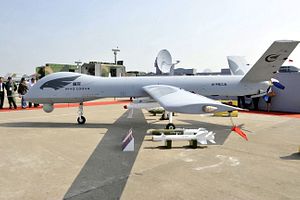After the June 18 crash of an unidentified unmanned aerial vehicle (UAV) near the city of Mianwali in Punjab province, some evidence has emerged that the UAV is not one regularly flown by the Pakistan Air Force (PAF). That has led to speculations that the Pakistani military is mulling the purchase of additional Chinese combat drones.
According to IHS Jane’s Defense Weekly, a Pakistani defense official speaking on the condition of anonymity said that the unmanned aircraft was on an “experimental flight.” This could indicate that the Pakistani military was evaluating a new UAV type for service in the PAF. Furthermore, IHS Jane’s Defense Weekly explains:
No official comment has been made on either the type of UAV involved or the crash itself. However, the Pakistani official (…) indicated that the crashed UAV — which has the appearance of a Chinese Wing-Loong unmanned combat aerial vehicle — was not among those regularly flown by the Pakistan Air Force, suggesting it may have been a newer platform that was still being tested.
Pakistan considered procuring the Wing Loong UAV in the late 2000s; however, the PAF opted for the China Aerospace Science and Technology Corporation’s (CASC) CH-3A instead. Both the Wing Loong and CH-3A are medium altitude long-endurance (MALE) UAVs, capable of firing laser-guided air-to-surface missiles.
According to some media reports, Pakistan is also considering purchasing the CH-4, an upgraded variant of the CH-3A, offering longer endurance and a larger payload. The CH-4 “can carry a payload of up to 350 kilogram including Lan Jian 7 (Blue Arrow 7) laser-guided air-to-surface missiles, TG100 laser/INS/GPS-guided bombs, and the AR-1/HJ-10 anti-tank missile – the Chinese equivalent to the American-made Hellfire missile,” as I explained last year. It closely resembles the U.S.-made General Atomics Aeronautical Systems’ MQ-9 Reaper drone.
In terms of size and payload, the Wing Loong UAV is comparable to the smaller General Atomics MQ-1 Predator. However, Chengdu Aircraft Corporation has been working on a larger second-generation Wing Loong II combat UAV, purportedly capable of carrying up to 12 air-to-surface missiles. According to some analysts, the Wing Loong UAV is equipped with a much weaker engine than either the Predator or Reaper and consequently has a more limited range and speed in comparison to U.S. models.
Pakistan’s indigenously-designed combat drone named Burraq, first inducted in November 2013, very much resembles the CH-3A, although it is unclear in what capacity China has supported Pakistan’s National Engineering and Scientific Commission (NESCOM) in the development of this new weapons platform. The Burraq UAV was for deployed in combat for the first time during counterinsurgency operations in the Federally Administered Tribal Areas (FATA) in September 2015.
































